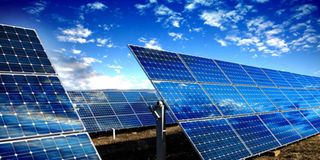Solar power on the rise as Africa fights rising fuel costs, outages

What you need to know:
- More Africans are rushing to catch up on solar energy as the cost of fossil fuels and natural gas goes up in some countries and as others push to move away from frequent power blackouts, a new report shows.
Nairobi. With rising fossil fuel costs and persistent power blackouts, countries like Egypt, Zambia, Nigeria, and Angola are stepping up their solar capabilities, shifting Africa’s concentration of solar power away from South Africa.
More Africans are rushing to catch up on solar energy as the cost of fossil fuels and natural gas goes up in some countries and as others push to move away from frequent power blackouts, a new report shows.
The Africa Solar Outlook 2025 report by the Africa Solar Industry Association (AFSIA) shows a rise in solar projects across the continent, including countries just starting to develop their solar industries - setting in motion a new trend that will make solar distribution on the continent more widespread.
Until now, the major solar player on the continent has been South Africa, which is currently the only country in the ‘GigaWatt Club.’
“In 2024, the lion’s share of solar in Africa has remained highly concentrated. 2025 may see a major shift in the distribution of solar though, as several landmark projects have started construction in countries that do not belong to the group of “usual suspects” for solar leaders in Africa,” said AFSIA Chief Executive Officer, John van Zuylen during the launch of the report.
Egypt, Zambia, Nigeria and Angola have been listed among countries that made significant gains, with some of the largest new solar capacities installed in 2024 in Africa, according to the new report.
Egypt is now ranked in second position, after South Africa, after moving up five places, representing 29% of the almost 2.5 gigawatt-peak (GWp) installed in Africa in 2024. The North African economy is experiencing a huge expansion in solar power generation on the back of a jump in cost of natural gas imports and low domestic gas production for the better part of 2024.
AFSIA report shows two large-scale solar projects commissioned in Egypt’s Kom Ombo area delivered 700 megawatt peak (MWp), almost closing in on South Africa’s 748MWp on mega projects in 2024.
“Several major projects have experienced significant progress or have been announced. In 2024, 40 GWs worth of new projects have been announced ... This represents a 21% increase of the projects pipeline compared to the same time last year and indicates a sustained desire from both the private and the public sector to roll out solar across the continent,” according to the report.
In December, Dubai-based renewable energy firm, AMEA commissioned a US$500 million, 500-megawatt solar plant in Aswan, Egypt with a capacity to generate approximately 1,500 GWh of clean energy annually.
“The solar power plant is a significant step in Egypt’s renewable energy strategy, supporting the goal of achieving 42% of energy generation from renewables by 2030,” said AMEA Power Chairman, Hussain Al Nowais in a statement.
AMEA plans to construct a second 1,000-megawatt power plant in Aswan, featuring a 600 MWh battery energy storage system (BESS). Once operational, the company said this project will be the largest of its kind in Africa.
In 2024, large-scale solar projects accounted for 72% of the newly installed capacity across Africa, a significant increase from 32.4% in 2023.
“The growth is even more striking when looking at absolute figures," according to AFSIA.
521 MW of large-scale projects were installed in 2023 while 1,783 MW were recorded in 2024 - a growth of almost 350%.
South Africa’s share of the overall installed solar capacity of the entire continent came in at 50% in 2024 - down from earlier years.
Zambia, which has relied predominantly on hydro-power for decades (with hydro-power making up 80% of its installed capacity), turned to solar energy in 'emergency mode' in 2024.
This shift was prompted by severe droughts that drastically reduced water levels in its primary dam, Kariba, leaving only one of the country’s six turbines operational.
In response, the country installed 74.8 MW of solar power, climbing to the third position in Africa in terms of solar installations in 2024, an improvement of eight slots, marking the second largest movement on the continent. Zambia’s government’s plan to generate 500 MW of solar power by 2025 has spurred investment in solar infrastructure, further increasing the market’s expansion.
“2024 saw a real boom of solar in Zambia,” the report said.
In Nigeria, the government's decision to remove fuel subsidies to curb corruption in the oil sector is also pushing the country towards solar due to increased electricity costs, according to the report. The West African economy rose six places to fourth position after installing some 63.5 MW.
“Nigeria starts feeling the positive impact of the fuel subsidy removal and an increased interest for solar+storage as a cheaper alternative to diesel,” said AFSIA experts.
Angola, another major oil-producing country, climbed 10 slots - the largest movement on the table - into the top, 5 bolstered by utility-scale solar projects. Two projects of of around 27 MW each were rolled out, after being started two years ago.



